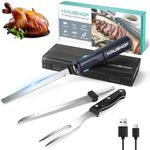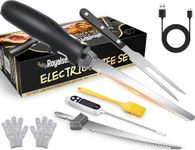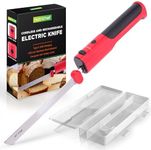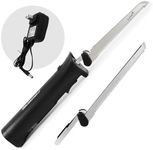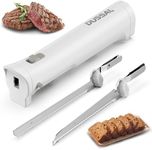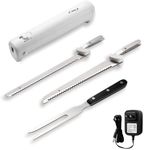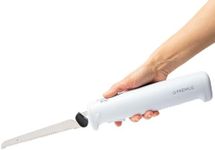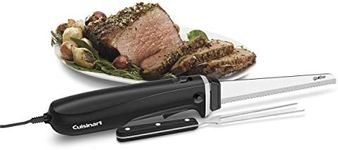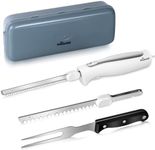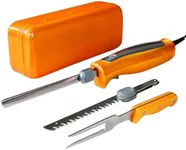Buying Guide for the Best Cordless Electric Carving Knife
Choosing the right cordless electric carving knife can make a significant difference in your kitchen experience, especially when it comes to carving meats, bread, and other foods with precision and ease. When selecting a cordless electric carving knife, it's important to consider several key specifications to ensure you get a product that meets your needs and preferences. Here are the key specs to look out for and how to navigate them.Blade MaterialThe blade material is crucial because it affects the knife's durability, sharpness, and ease of cleaning. Common materials include stainless steel and high-carbon stainless steel. Stainless steel blades are resistant to rust and corrosion, making them low-maintenance and long-lasting. High-carbon stainless steel blades are even sharper and more durable but may require more care to prevent rust. If you need a knife for heavy-duty carving, opt for high-carbon stainless steel. For general use and easier maintenance, stainless steel is a good choice.
Blade LengthBlade length determines how versatile the knife is for different types of carving tasks. Blades typically range from 7 to 10 inches. Shorter blades (around 7-8 inches) are easier to control and are ideal for smaller cuts of meat or bread. Longer blades (9-10 inches) are better for larger roasts and turkeys, providing more reach and efficiency. Consider what types of food you will be carving most often to choose the appropriate blade length.
Battery LifeBattery life is important because it determines how long you can use the knife before needing to recharge it. Look for knives with longer battery life if you plan to use it frequently or for extended periods. Battery life can range from 20 minutes to over an hour. For occasional use, a shorter battery life may suffice, but for regular or heavy use, opt for a knife with a longer battery life to avoid interruptions during carving.
Charging TimeCharging time affects how quickly you can get back to using your knife after the battery runs out. Some knives can take several hours to fully charge, while others may have quick-charge features that allow for shorter charging times. If you need a knife that is always ready to go, look for models with faster charging times or quick-charge capabilities. This is especially useful if you often forget to charge your devices in advance.
Weight and ErgonomicsThe weight and ergonomics of the knife affect how comfortable it is to use, especially for extended periods. A lighter knife is easier to handle and reduces hand fatigue, while a well-designed ergonomic handle provides a better grip and control. If you have smaller hands or plan to use the knife for long carving sessions, prioritize a lightweight and ergonomically designed model. Test the knife if possible to ensure it feels comfortable in your hand.
Safety FeaturesSafety features are important to prevent accidents and ensure safe operation. Look for knives with features such as a safety lock, which prevents the knife from accidentally turning on, and a blade release button for easy and safe blade removal. If you have children or pets in the house, or if you are concerned about safety, prioritize models with robust safety features to minimize the risk of injury.
Ease of CleaningEase of cleaning is important for maintaining hygiene and prolonging the life of the knife. Some knives have removable blades that are dishwasher safe, making cleaning more convenient. Others may require hand washing. If you prefer low-maintenance kitchen tools, look for a knife with dishwasher-safe components. Otherwise, ensure that the knife can be easily disassembled for thorough cleaning by hand.
